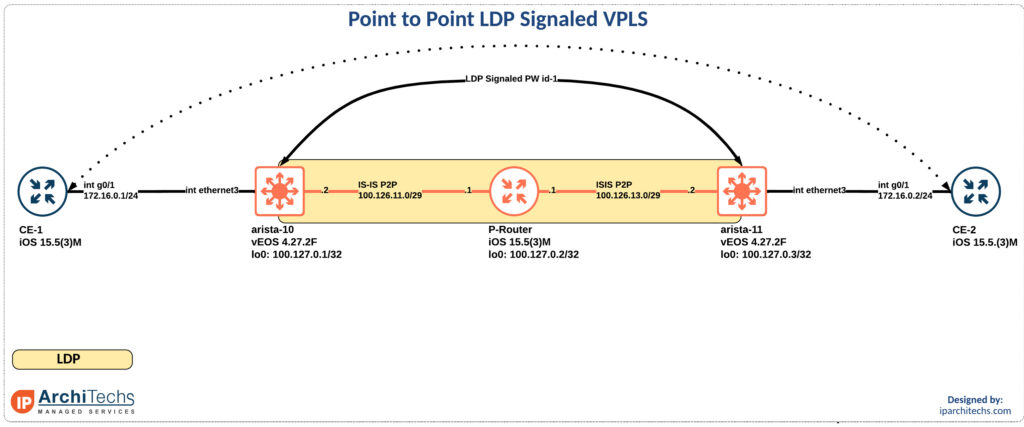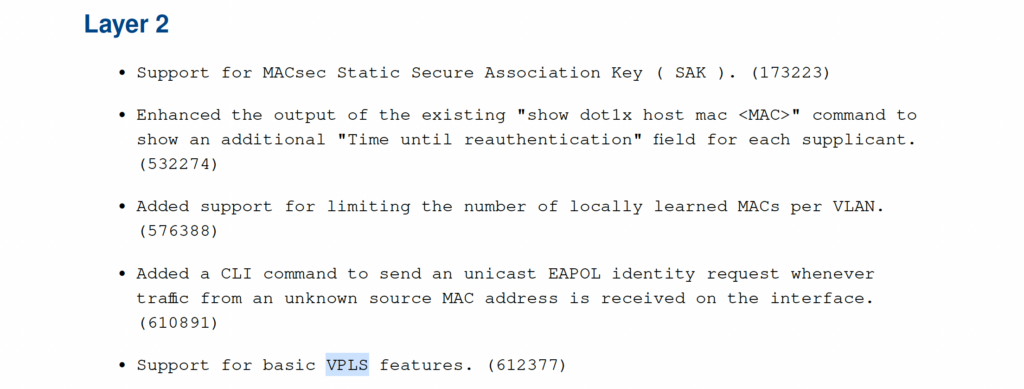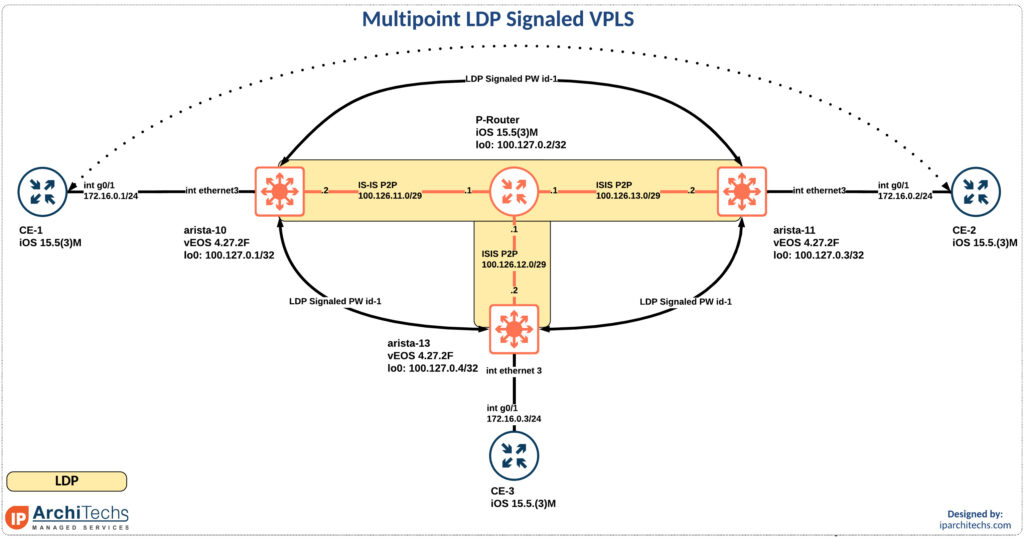During the first networking field day: service provider one of the big topics was EVPN versus VPLS. Arista has put a lot of work into their EVPN deployment and this has give then a ton of success in the data center. However, a large portion of the provider space, especially last mile providers, rely on VPLS heavily. This naturally led to discussion about Arista VPLS support.
I’m pleased to see that there is now basic support in EOS as of EOS 4.27.2F and more on the roadmap. Hopefully, we’ll see the off ramp, RFC8560, from VPLS to EVPN which was a hot button topic throughout the week.


In the release notes for EOS 4.27.2F it calls our basic VPLS support. So I took a look. Reviewing the new 4.27.2F manual I found support for LDP PWs on RFC4447 which is virtual private wire support. This also appeared to be in EOS 4.26 but not earlier. Thanks to Arista for providing more documentation on their support for RFC4762 – LDP signaled VPLS.
In the meantime lets review how this works:
mpls ip
!
mpls ldp
router-id 100.127.0.3
transport-address interface Loopback0
no shutdown
!
pseudowires
pseudowire TEST-PW
neighbor 100.127.0.1
pseudowire-id 1
mtu 1500
!
patch panel
patch TEST
!
patch TEST-PW-PATCH
connector 1 pseudowire ldp TEST-PW
connector 2 interface Ethernet3
!You have to define the end point for the LDP signaling in the LDP configuration. The configuration requires an endpoint (neighbor), pseudowire-id, and mtu. Without all three of these the PW won’t establish.
Then tie the port you want to use the PW with a patch panel connector. In this case we tied ethernet3 to PW TEST-PW.
Everything that comes in on Ethernet3 will be pushed into the PW and on to the endpoint. Let’s verify that the signaling mechanism works:
arista-11#show patch panel detail
PW Fault Legend:
ET-IN - Ethernet receive fault
ET-OUT - Ethernet transmit fault
TUN-IN - Tunnel receive fault
TUN-OUT - Tunnel transmit fault
NF - Pseudowire not forwarding (other reason)
Patch: TEST, Status: Down, Last change: 0:26:17 ago
Patch: TEST-PW-PATCH, Status: Up, Last change: 16:35:05 ago
Connector 1: LDP neighbor 100.127.0.1 PW ID 1
Status: Up
Local MPLS label: 116384, Group ID: 0x0
MTU: 1500, 802.1Q VLAN request sent: -
Flow label capability: none
Supported VCCV CV types: LSP ping
Supported VCCV CC types: Router alert label
Neighbor MPLS label: 116384, Group ID: 0x0
MTU: 1500, 802.1Q VLAN request received: -
Flow label capability: none
Supported VCCV CV types: LSP ping
Supported VCCV CC types: Router alert label
PW type: 5 (raw), Control word: N
Flow label used: no
Tunnel type: LDP, Tunnel index: 1
Connector 2: Ethernet3
Status: UpCE-1#ping 172.16.0.2
Type escape sequence to abort.
Sending 5, 100-byte ICMP Echos to 172.16.0.2, timeout is 2 seconds:
!!!!!
Success rate is 100 percent (5/5), round-trip min/avg/max = 14/18/22 msNow we have a functional layer 2 link between the distance CEs.


An important note if you want to put this into production is you have to use service routing protocols model multi-agent which requires a reboot of your devices.
There are also some restrictions in vlan translation/passing which I will explore in a future post. Now let’s check out the basic configuration.
After reviewing the documents for LDP signaled VPLS we built the topology above. All 3 PEs are in the same mesh so the 3 CE routers are all layer 2 adjacent.
I probably made every mistake you could as I started building this but the CLI is pretty helpful in what is wrong.
arista-11#show vpls
VPLS: TEST-VPLS
VLAN: 10, 802.1Q tag: -
MAC withdrawal trigger for local interface going down: Y
Pseudowire group: MESH, split-horizon
MAC withdrawal trigger on pseudowire failure: N
MAC withdrawal propagation: locally triggered
LDP neighbor 100.127.0.1 PW ID 1 PW name ARISTA-10
Status: No remote, Interface: Pseudowire3.0
LDP neighbor 100.127.0.4 PW ID 1 PW name ARISTA-13
Status: CLI incompleteI originally missed specifying the MTU on the CLI so it told me my configuration was incomplete. I thought this was pretty neat as it prevented me from going down a bunch of different paths to determine why my original build was broken.
arista-13
mpls ldp
router-id 100.127.0.4
transport-address interface Loopback0
no shutdown
!
pseudowires
pseudowire ARISTA-10
neighbor 100.127.0.1
pseudowire-id 1
mtu 1500
!
pseudowire ARISTA-11
neighbor 100.127.0.3
pseudowire-id 1
mtu 1500
!
router vpls
vpls TEST-VPLS
ldp mac withdrawal trigger interface
!
vlan 10
!
pseudowire ldp MESH split-horizon
pseudowire ARISTA-10
pseudowire ARISTA-11
!
endarista-13#show vpls
VPLS: TEST-VPLS
VLAN: 10, 802.1Q tag: -
MAC withdrawal trigger for local interface going down: Y
Pseudowire group: MESH, split-horizon
MAC withdrawal trigger on pseudowire failure: N
MAC withdrawal propagation: locally triggered
LDP neighbor 100.127.0.1 PW ID 1 PW name ARISTA-10
Status: Up, Interface: Pseudowire1.0
LDP neighbor 100.127.0.3 PW ID 1 PW name ARISTA-11
Status: Up, Interface: Pseudowire2.0CE-3#ping 172.16.0.2
Type escape sequence to abort.
Sending 5, 100-byte ICMP Echos to 172.16.0.2, timeout is 2 seconds:
.!!!!
Success rate is 80 percent (4/5), round-trip min/avg/max = 11/14/17 ms
CE-3#ping 172.16.0.1
Type escape sequence to abort.
Sending 5, 100-byte ICMP Echos to 172.16.0.1, timeout is 2 seconds:
.!!!!
Success rate is 80 percent (4/5), round-trip min/avg/max = 11/12/14 ms
CE-3#If you need help with your deployment reach out to us at IP architechs.
 +1 (855) 645-7684
+1 (855) 645-7684